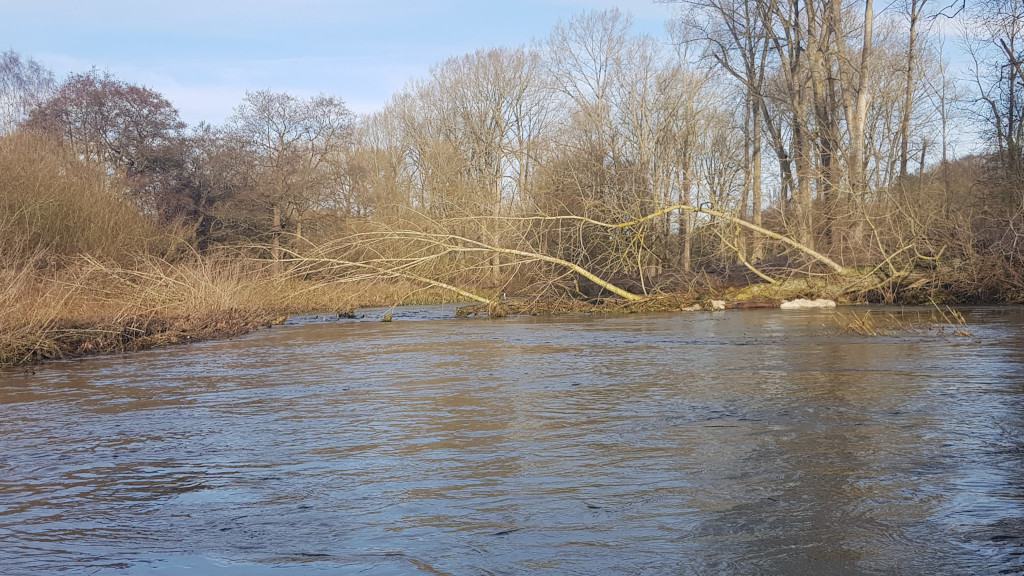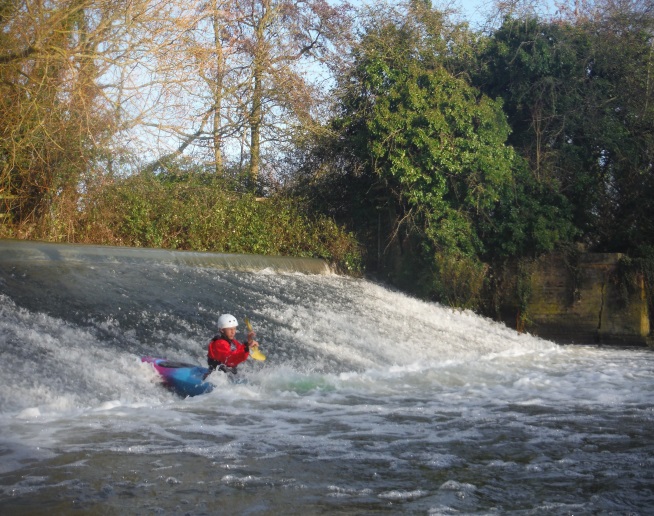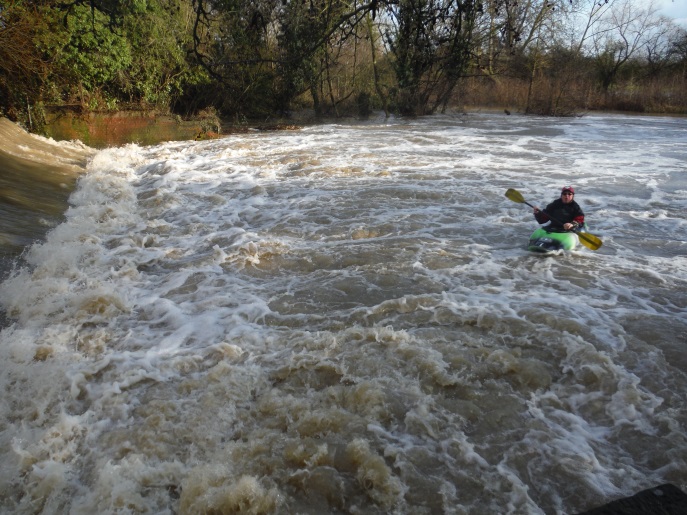When the rivers are full of water

When it rains, our rivers fill with water, and what was once a relatively benign environment can soon become a lot more hazardous. As a rule of thumb, if a river has a lot of water in it, and you are unsure about your paddling ability, then it is better to find somewhere else to paddle – e.g. a small lake.
Look at the risks below. Think about the river you are about to paddle on and consider if any of the risks could be encountered on your trip. If any are relevant, then consider how you would deal with them if they did arise and you don’t have a good mitigation then consider paddling elsewhere or even doing something else until the river levels drop again.
There are many near missed each year – these are generally not reported. Sadly, the cases which are reported are usually fatalities, such as this case: https://www.bbc.co.uk/news/uk-england-derbyshire-35262888
The old adage, “Better Safe than Sorry” most definitely applies when deciding whether to paddle a swollen river.
Additional Risks associated with Paddling on Swollen Rivers (And paddling in the Winter Months):-
- The Speed of the Current: This will vary along the passage of the river. In wide, deep areas the current can be relatively slow, but where the river narrows/gets shallow, the speed of the current will increase. If you are proposing a round trip, then try to paddle against the flow on the way out – that way you can be reasonably confident you will be able to make it back to the start point at the end of the day.
- Obstructions: Trees, Fences, Low Bridges and other obstacles which are normally out of the river flow, can become serious hazards as the river levels rise and the flow increases. Barbed wire can be particularly nasty if the river flows through a barbed wire fence. Trees can also be a problem if paddling up stream, as if you slightly lose control you can find yourself pushed backwards onto a tree.
- Access/Egress Points: Access to and Egress from rivers is often above/below a dangerous feature, such as a sluice or weir. When rivers are flowing fast, these access points can become quite dangerous, as if you fall in whilst trying to get on/off the river, you and your equipment will quickly be flushed into the weir/sluice. Where possible, find an access point further upstream of a feature, and make sure your group has a plan in case of an issue.
- Confused Current: As the water levels rise, the river has much more powerful currents in it. These mainly flow down river, but also swirl around and if this catches the edge of your craft this can tip you in. At the edges of the river the flows can be powerful and may flow in the opposite direction to the flow of the main river.
- The Outside of Bends: The Outside of Bends are particularly dangerous places when a river is flowing fast. This is because the water tries to flow straight, so piles into the outside of the bend, scouring the bank away and sometimes undercuts, causing the trees to end up in the river. As a paddler, you will get pushed into the trees on the outside of the bend, where the water is flowing at its fastest – clearly not a nice place to be.
- Fallen Trees and other obstructions: In any condition we must be ready to cope with the unexpected. But when a river is swollen, obstructions such as trees across the river become more likely – what would you do if you suddenly found the river blocked ahead?Carry a fold up saw
- Debris floating down the river: You will often find debris in the river. This could be trees, fenceposts (e.g. with barbed wire attached), dead animals etc.
- Illness: As rivers rise, sections of the riverbank that don’t normally get wet become submerged. This includes areas where animals live and in animals’ urine there are some nasty diseases. One particular, Leptospirosis (Weil's disease) is carried in rats’ urine, the concentrations of which can increase when rivers flood through their burrows. Paddlers can pick it up through the mouth, eyes, or a cut. https://www.nhs.uk/conditions/leptospirosis/
- Cold: It is usually during the winter months when the rivers are more susceptible to flooding, and when the conditions are also likely to be much colder than in the summer. Whilst the water is rarely warm in the UK, the air in the summer is much warmer, and the sun is often out. In the winter, you can get cold very quickly if you get wet, especially if your equipment is not great. When the rivers are swollen, the chances of you getting wet increases, and when that happens, any wind will rapidly lead to you getting cold, especially if you are paddling a SUP or SOT as you are much more exposed to the elements on these craft. Wind Chill can be a significant factor in the winter – Waterproof layers on top of wetsuits can make a significant difference to how warm you keep.
- Water Level Change: River water levels are dynamic – they rise and fall. There can be a significant lag between when it is raining and when the water levels rise/fall. So, even days after heavy rain, the water levels can still be rising. Also, the Environment Agency control the locks and weirs to manage the release of the water. This is done to reduce flooding, not for the benefit of paddlers, and when they change the settings, this can lead to rapid river level changes, there may be bridges you wont be able to get under.

Rushes Weir - Low Water - Reasonably Safe

Rushes Weir - High Water - Unsafe
- Sewage Discharge: When there is a lot of rain, the sewage treatment works can become overloaded, leading to sewage discharge into the rivers.
The simple rule of thumb is “If in doubt, don’t”. This year alone there has already been several near misses. If you want to paddle on rivers that are flowing fast, then you need to get some training first, and you should paddle in a group with experienced paddlers who carry appropriate rescue equipment (e.g. rescue knife, rescue saw, throw line, pin kit, first aid kit, emergency shelter etc.)
- Can you control your passage? You should be able to control your passage down the river, in the current that is there. You should always be able to get yourself to a place of safety (e.g. the bank) within the distance you can see. If your sight lines are reduced, then stop and check before continuing.
- Have you got the Skills? You should understand the likely challenges you will meet, and understand what to do if you come across them. e.g. If you get washed onto a rock/tree what do you do? Can you paddle backwards against the current?
- Does your Group have enough Experience? There is no substitute for paddling with people who are experienced and able to put a safe operating procedure around your activity. Local clubs are very good at providing this training and practice.
- Labelling Kit: Please ensure your kit is labelled with you name and contact details, so if a paddle or boat are lost, the emergency services can identify you and ensure you are safe.
- Group Sizes: As a general rule paddlers in challenging conditions work in groups of 3 or more. Clearly the definition of challenging is different depending on the individual’s skills, experience and training. Paddling in groups is not always permissible during Covid restrictions.
Paddling swollen rivers may seem like a bit of an adventure, but it is a serious business. Coaches and Leaders train for many years to build their experience and skills so they can lead in these hazardous environments. Do not underestimate the challenge or the risks involved. Every year there are near misses and in some sad cases, worse.
Above all, keep safe. If in doubt, find a group that has training and experience of leading on rivers. The appropriate British Canoeing qualifications for a leader would be a “British Canoeing Coach” (specific to moderate environments) or a “British Canoeing Moderate Water Leader”.
Swollen rivers are much more challenging than in their normal, summer levels. Weirs that you can slide down and swim in the summer can become death traps as the levels rise, which has sadly caught out even top white water paddlers. In the end, its important to carry out a dynamic risk assessment when looking at the river. The test of a good leader is having the courage to say to the group not today - we need to find somewhere else or paddle another day
![]() When the Rivers are Full of Water
When the Rivers are Full of Water
Previous page: Safety Notes
Next page: Tidal rivers - staying safe